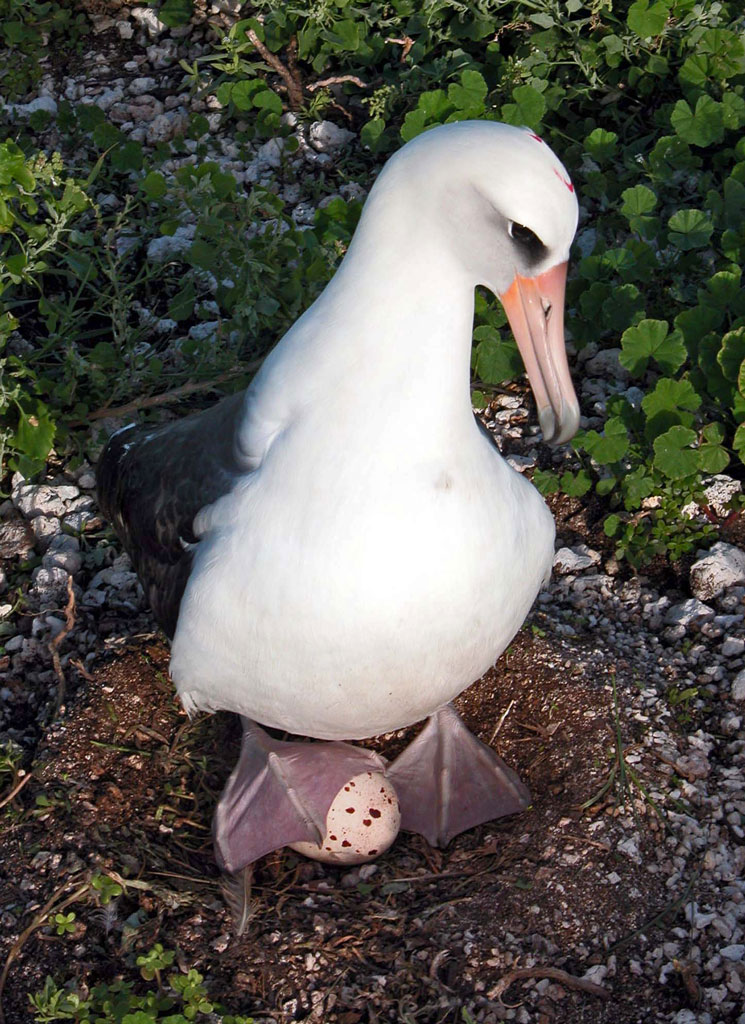Published in the Ocean Watch column, Honolulu Star-Advertiser © Susan Scott
December 1, 2006
Last weekend, Craig and I took a minivacation to Kauai where we visited Kilauea Point National Wildlife Refuge, a prime nesting site for seven of Hawaii’s seabirds. As we pulled into the parking lot, several Laysan albatrosses greeted us, doing what they do best: soaring. Since the refuge is at the top of a sea cliff, the updrafts the seabirds ride there let you see them eye to eye.
But the albatrosses weren’t there just saying hello. They were there because that’s where they were raised, and therefore, that’s where they will mate and raise their own families.
 Laysan albatross with egg at Tern Island,
Laysan albatross with egg at Tern Island,
Northwest Hawaiian Islands National Monument
The red mark on this bird’s head is a dab of nail poilish to let biologists know the bird’s band has been read. The nail polish wears off after a few days at sea.
Laysans have been nesting at and around Kilauea Point for years, some successfully, some not. Those that lay their eggs inside the 203 acres of protected land have a pretty good chance of raising an offspring to the point it flies away. But those that nest on nearby private land, where both wild and domestic dogs prey on the chicks, have more failures. Even inside the refuge, some eggs are infertile and some chicks die.
If an albatross egg or youngster is lost, the couple, which produces only one egg a year, stays geared up for a while to sit on an egg and feed a chick. And any albatross egg or chick will do. Albatrosses are famous for being doggedly faithful to the nest site of their birth, and they’re also known to readily adopt another albatross’s offspring.
This fact of nature became useful to Navy specialists looking for ways to reduce the risk of aircraft striking albatrosses near the Pacific Missile Range Facility near Kauai’s Barking Sands. Laysans nest in that area.
Moving these hard-wired birds, though, is a tough task. At Midway in the 1950s, sailormen (as Time Magazine called them in a 1959 article) tried to shoo albatrosses from runways by burning old tires, dropping flares and firing rifles, bazookas and mortars. All failed.
Navy personnel then tried flying planeloads of albatrosses to Guam, Kwajalein, Japan and Puget Sound. All the birds came back.
In another rather sweet strategy, Navy workers built the albatrosses their own open-space runways on nearby Kure. Not one bird relocated.
Finally, between 1954 and 1964 the Navy employed a “bird abatement program,” killing more than 54,000 albatrosses near Midway’s runways. It was a sad solution, but you can’t say they didn’t try.
Today the Navy is still trying to do the right thing. In 2005, Navy BASH (Bird Aircraft Strike Hazard) specialists and Kilauea Point biologists moved 26 Barking Sands eggs and chicks into 26 failed nests at Kilauea.
All the foster parents adopted and raised their hanai offspring. When it’s time for these transplants to raise families, they’ll now do it at Kilauea, rather than Barking Sands.
The rub here is that albatrosses can live for 50 years. Therefore, the adoption program must continue for a long, long time before Barking Sands’ strike hazard is significantly lowered. Still, this elegant solution to an old problem is in its third year and seems likely to continue.
Kilauea Point is one of the few national wildlife refuges in the country open to the public. It’s the only one, though, operating an albatross adoption agency.